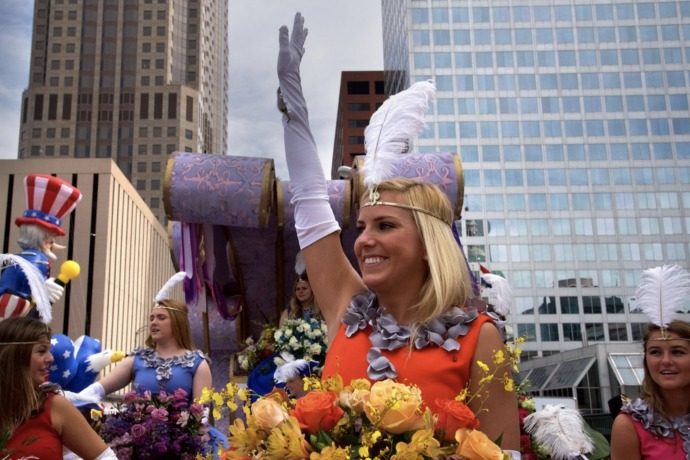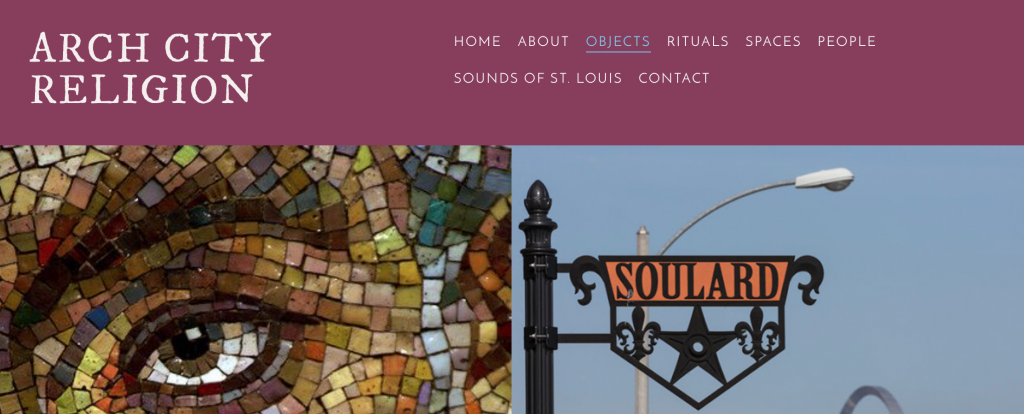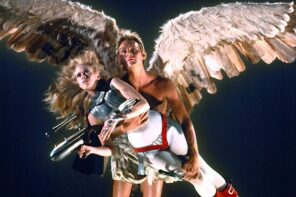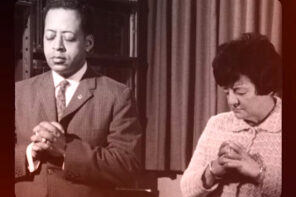On July 1st an event trademarked as “America’s Birthday Parade” rolled through the streets of downtown St. Louis and across television sets coast-to-coast. This civic celebration served the cause of St. Louis boosterism (“Great Things Are Happening!” in the Gateway to the West, the parade’s logo declared) as well as offering an expression for patriotic pride (veterans were honored, and our national colors were much used).
In many ways a throwback to an earlier time in American entertainment, complete with majorettes and marching bands, this event likely did not look, to most spectators, much like a manifestation of “religion.” But the backstory of this ordinary-seeming street festival reveals elaborate connections between religious vocabulary and the policing of American racial boundaries, the power of capitalism and its reliance upon class distinction, the use of entertainment as a means to squelch labor unrest—not to mention arcane puberty rituals straight out of an anthropology textbook.
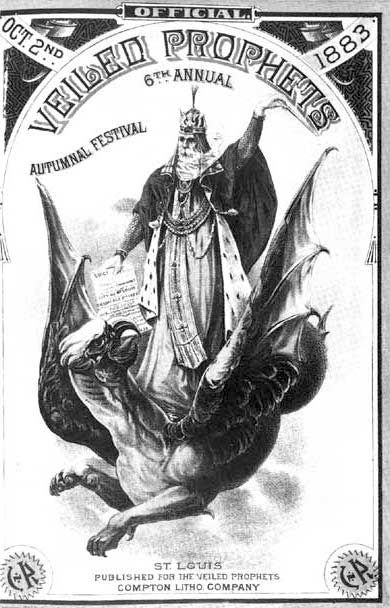
Program title page, Sixth Veiled Prophet Festival, 1883, produced by the Compton Litho Company
The year 2017 marks the 135th instantiation of what has long been known in St. Louis as the Veiled Prophet Parade, a public event hosted by a secret society founded in 1878. Organized around a gun-toting, masked mystic (the Veiled Prophet of Khorassan), the VP Organization, as it is commonly known today, functioned simultaneously as a fraternal society for the city’s ruling white elites and a bit of bread and circuses for the working classes, who had launched a serious challenge to their bosses via a railroad strike in 1877. In response, a mysterious figure, enthroned on a float, presiding over a fireworks display, plus general pageantry and philanthropy “reinforced the notion of a benevolent cultural elite,” as the St. Louis city website puts it.
The organization still runs a debutante ball where men of high society display their daughters to one another once they come of age. “The preeminent formal gala for introducing young ladies,” as the Veiled Prophet Organization puts it. The gala gives the young women a chance to feel like princesses, guarded by men made up in Orientalist drag as “Bengal Lancers,” the sort of racist play that marked the fraternal societies of the early twentieth-century but now feels creepily out of touch.
African Americans weren’t allowed into the organization until 1979, after years of growing protest over the link between the Veiled Prophet, whiteness, and wealth (in 1972, one protestor slid down an electrical cable to publicly unmask the then-prophet as a VP of corporate agribusiness giant Monsanto). In more recent decades, explicit reference to the Veiled Prophet has itself been veiled—either abbreviated or replaced with new, generically wholesome titles for the events sponsored by the Veiled Prophet Organization, like “Fair St. Louis” or “America’s Birthday Parade.”
As both exclusive ritual and public spectacle, intentionally exotified mumbo-jumbo and old-fashioned class warfare (and appeasement) via street parade, the case of the Veiled Prophet offers a lens for thinking about American religion, and this history and ongoing practice is being put to such use in the Arch City Religion Project, one of the latest digital means of mapping (and remapping) American Christianities and American religions more broadly.
Run by St. Louis University professor Rachel McBride Lindsey, a scholar of religion and visual culture and author of the recently released A Communion of Shadows: Religion and Photography in Nineteenth-Century America, the Arch City Religion Project is a teaching project focused not only on making information (like the backstory of the Veiled Prophet Parade) available to the public but also on nudging both contributors and consumers of the project to think critically about research on religion. The site aims “to exercise responsible communication about complex histories and practices of faith in St. Louis,” which necessitates a good degree of untangling of narrative threads and close scrutiny of sources.
What distinguishes this project in particular is its multimedia emphasis. Not only does it offer visitors sound clips and images, videos and text, it also approaches the auditory and the visual and the material as sources demanding critical “reading.” Thus, the Project offers tabs for “objects,” “rituals,” “spaces” and “sounds” as well as “people,” offering analysis of the retouching of photographs of a house associated with the 1949 St. Louis Exorcism and investigating the intersections of religion with commerce and race in a fascinating discussion of the sale of “authentic” Native American artifacts at Pathways New Age Books and Music.
Like the American Religious Sounds Project, (discussed in a previous column on the possibilities represented by digital mapping and remapping of American religion), the Arch City Religion Project allows a visitor to follow chance connections, visit virtual places never heard of before, and experience, via media, events both intimate and public—like an interview with a same-day surgery nurse at St. Louis Children’s Hospital or a view of the Way of Lights at the National Shrine of Our Lady of the Snows. The contributors here have also drawn their own connections, linking a photograph showing a sea of raised hands under the Gateway Arch, a detail of a civil rights protest, with an analysis of the ideology of Manifest Destiny and its role in American history and culture.
After reading about the history of the Veiled Prophet movement, visitors can click through to a piece on the miracles associated with the Shrine of St. Joseph or an analysis of both affect and argument in the collection of the Museum of Contemporary Religious Art, on the St. Louis University campus.
Such juxtaposition points to the ultimate use of the Arch City Religion Project as, itself, a kind of lens, a tool through which citizens—scholars and students as well as congregants, laypeople, policy makers, even parade-goers—can see the familiar in a new light. Drawing attention to that which is so ubiquitous as to be invisible (with a detailed article on the fleur-de-lis, for instance, or on a dedicated graffiti wall), the Project also helps its viewers look with the eyes of a religionist at the taken-for-granted manifestations of culture all around them—from the tribalism of local high schools to the “human and mechanical menagerie of the funny and outlandish, mixed with the patriotic” that is the Veiled Prophet Parade.
After a pirate ship tossing out a booty of candy and Shriners in minicars and men in suits blasting the crowd with water guns in imitation of a movie poking fun at conspiracy theories regarding government coverups of alien contact, this month’s parade featured:
A blow-up Uncle Sam, six stories high… followed after a while by a four-story American eagle, and a six-story firefighter. A real bald eagle rode a keeper’s arm on the World Bird Sanctuary’s float, along with an owl and a big green snake.
Mythic narratives and cultural heroes mixed with symbols of identity and values, all in a mass ritual, half pedagogical spectacle, have carnivalesque escape from the banal: this is the sort of complicated human story, of the forms and roles of American religiosity, that digital platforms like the Arch City Religion Project help to unveil.


